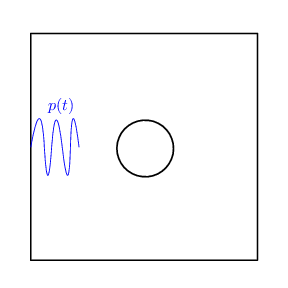Wave scattering by an elastic sphere submerged in an incompressible fluid is described by the equation
| (1) |
where:
-
is the displacement [m]
-
is the density [kg/m]
-
are the bulk, shear elastic moduli [N/m].
Elastic media sustain two types of waves:
-
longitudinal or -waves (pressure waves) with wave velocity
-
transverse or -waves (shear waves) with wave velocity
Consider a plane pressure wave , entering a cube of side m filled with water ( kg/m, m/s, ) containing a steel sphere of radius m ( kg/m, m/s, m/s) (Fig. 1)
 |
Consider the Helmoholtz decomposition . The time evolution equations for are
Looking for solutions of form leads to the Helmholtz equations
The above formulations are solved in the same cases considered in Homework04
-
Solve the above Helmholtz problems in 2D plane geometry using FreeFEM.
-
As above, scattering around a cylinder.
-
As above, scattering around a sphere.